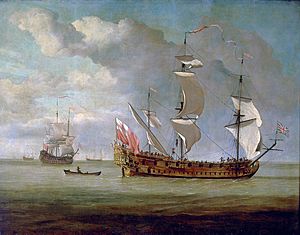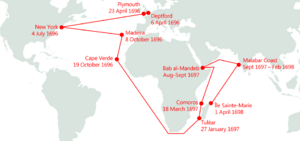Adventure Galley facts for kids
Quick facts for kids History |
|
|---|---|
| Name | Adventure Galley |
| Builder | William Castle, Deptford? |
| Cost | 8,000 pounds sterling |
| Launched | 4 December 1695 |
| Fate | Sunk, April 1698 |
| General characteristics | |
| Class and type | oared frigate |
| Tons burthen | 287 |
| Length | 124 ft (38 m) (keel) |
| Beam | 28 ft (8.5 m) |
| Draught | 9 ft (2.7 m) |
| Propulsion | Sails, one bank of oars |
| Sail plan | Ship rig |
| Speed |
|
| Complement | 160 men |
| Armament | 34 light cannon |
Adventure Galley, also known as Adventure, was an English merchant ship led by Scottish sea captain William Kidd. This ship was special because it used both square rigged sails and oars. This design helped it move well in both windy and calm seas. The ship was built in late 1695. Captain Kidd got it in 1696 for his mission to hunt pirates.
From April 1696 to April 1698, Adventure Galley sailed thousands of miles across the Atlantic and Indian Oceans. Captain Kidd was looking for pirates, but he didn't find any for a long time. Because he hadn't found any treasures, Kidd himself started taking ships. Adventure Galley captured two ships near India. They brought these ships back to Madagascar. But by spring 1698, Adventure Galley's hull was very old and leaky. It could no longer sail safely. The crew took off anything useful, and the ship was sunk off Madagascar's coast. Its remains have not been found yet.
Contents
Building and Buying the Adventure Galley
Why the Ship Was Bought
A group of investors bought Adventure Galley for Captain Kidd. They wanted to find pirates and take their stolen treasures. The plan was to share the treasure among the investors. Kidd got help from important people like Richard Coote, 1st Earl of Bellomont, who was a governor. He also got support from Robert Livingston the Younger.
With this support, Kidd received a special permission from King William III. This permission allowed him to be a privateer. A privateer was like a government-approved pirate. They could attack enemy ships or pirates and keep some of the treasure. The king himself would get one-tenth of any money found.
The Ship's Special Design
Adventure Galley was bought for £8,000 in August 1696. It was built at Captain William Castle's shipyard in Deptford, near London. The ship was launched on December 4, 1695.
Its design was unusual for warships of that time. It had three masts with sails, like a regular sailing ship. But it also had two rows of oars. This allowed the ship to move at 14 knots (26 km/h; 16 mph) with full sails. It could also move at 3 knots (5.6 km/h; 3.5 mph) using only oars.
Rowing was slow, but it was very useful. It meant the ship could move even when there was no wind. Other ships that only used sails would get stuck. This design was inspired by wars against Barbary pirates in North Africa. Their oared ships were very strong.
Ship's Quality and Weapons
Adventure Galley had 32 light cannons. It is not clear if the ship was brand new or if it was meant for the navy. It might have been a trading ship being fixed up when Kidd's group bought it.
The ship did not seem to be built very well. Captain Kidd had many problems with it leaking during its short time with him. Sometimes, shipyards would use cheaper materials to save money. This could make ships less strong. We don't have a picture of Adventure Galley. But HMS Charles Galley was a similar ship. Pictures of HMS Charles Galley show how English ships used the oared design for fighting.
Adventure Galley's Journeys
Adventure Galley left Deptford on April 6, 1696. Kidd sailed it to Plymouth in England. Then, on April 23, he set sail for New York. He arrived there around July 4. On the way, he captured a French fishing boat. He sold the French boat in New York. There, he also found more crew members.
On September 6, he sailed again, heading for the Indian Ocean. Adventure Galley stopped at Madeira and Boa Vista, Cape Verde for supplies. The long trip around the Cape of Good Hope took the rest of the year. Finally, on January 27, 1697, Adventure Galley reached Tuléar (now Toliara), Madagascar.
Challenges on the Voyage
By this time, Adventure Galley needed new sails and ropes. The old ones had lasted only eight months. This suggests they might have been poor quality. After a month in Tuléar, Adventure Galley sailed to Johanna (now Anjouan) in the Comoros. This was a place where East India Company ships often got repairs.
However, Kidd could not get money from local traders for new ropes or sails. So, he took Adventure Galley to another island. There, they cleaned the ship's hull. This process is called careening. It removes barnacles and weeds. This was done successfully, but many crew members got sick. About a third of them died from a disease, possibly malaria or yellow fever. Kidd went back to Johanna to find new crew. This time, he was able to get credit for new sails and ropes.
Turning to Taking Ships
According to Kidd, he "steered for India" on April 25, 1697. He had been away from London for a year. He had not found any pirate treasure. He had failed to find any pirates. So, he decided to start taking ships himself.
Adventure Galley did not go straight to India. It went to the Bab el-Mandeb strait, near the Red Sea. There, it reportedly tried to attack a Mughal trading group, but failed. In September 1697, Adventure Galley reached the Malabar Coast of India. Here, Kidd finally captured two merchant ships. They were called Rouparelle and Quedah Merchant. These ships were sailing with French passes.
Unfortunately for Kidd, the Quedah Merchant was led by an English captain. When news of its capture reached London, Kidd was called a pirate.
The Ship's Final Days
Adventure Galley's last journey took it to Île Sainte-Marie. This was a place where pirates often gathered off Madagascar. By now, Kidd said his ship was "very leaky." This was probably because the hull was rotten. The ship arrived there around April 1, with the captured Rouparelle (renamed November) and Quedah Merchant (renamed Adventure Prize).
When they arrived, most of the crew left Kidd. They joined another pirate captain, Robert Culliford. They also sank the November. Kidd was left with only thirteen men for Adventure Prize and the now-unseaworthy Adventure Galley.
One of Kidd's crew members, William Jenkins, said that after the crew left, Kidd "run Adventure Galley on shoar in Madagascar. They stript her furnishings and set her on fire to get her iron worke." But Kidd's own story was different. He said his small crew "could not keep the galley from sinking, and went on board of the prize [i.e. Quedah Merchant]."
Searching for the Wreck
We don't know much more about the ship's final location. The Discovery Channel asked Barry Clifford, a famous underwater explorer, to find Adventure Galley. This was for a TV series in 1999–2000. He thought he found the wrecks of Adventure Galley and Rouparelle/November. He also believed he found other pirate ships.
During his digs, Clifford found wood from English oak trees. He also found a few small items. He said these came from Adventure Galley. In 2015, Clifford found a 50 kilograms (110 lb) metal bar. It had the letters S and T on it. He claimed it was made of silver.
However, scientists and experts disagree with Clifford's findings. A UNESCO expert team looked at the site. They said it was not a shipwreck. They believed it was just a broken part of old port buildings. They also said the metal bar was 95% lead. It was probably just a heavy weight used on a ship.
See Also



